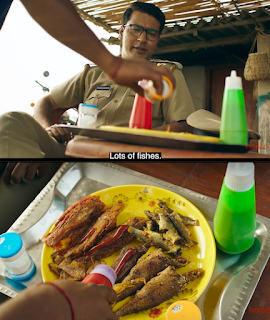Wrote a short piece about Macbeth adaptations for India Today, centering on the two most recent ones: The Tragedy of Macbeth (gorgeous-looking film, though I had a few reservations about it) and the Bengali series Mandaar, which sags a bit in the mid-section but makes some very interesting choices
-----------------------------------
Everyone in the coastal village of Geilpur smells of fish, someone observes in the new Bengali series Mandaar. “And I’m a cat. Meow!” replies a newly arrived cop named Mukaddar, speaking in effete-sounding English. In another scene he liberally pours ketchup over the catfish on his plate, a culinary travesty. 
After setting things up with a striking version of the “Fair is foul and foul is fair” opening, this five-episode series meanders for a while – but it soon builds in intensity again, with some powerful scenes such as one where Mandaar, beset by ghostly visions, pursues Pedo, the weird young boy who is one of the “witches”. Or a nightmare shot in desaturated colours, emphasising the redness of the characters’ clothes while rendering much else monochrome.
Even last year’s Malayalam film Joji, though only tenuously inspired by Macbeth, does witty things with some of the play’s iconic moments: with the story playing out in Covid time, the instruction “Put on a mask and go there” is a practical one, but also a nod to the many mask references (“False face must hide what the false heart doth know”) in the original work.
On one hand, non-Anglophone adaptations like Mandaar and Joji provide their own spins on Shakespeare’s prose and on key passages: take the use of Noh theatre elements in Kurosawa’s Throne of Blood, which brings a still, eerie quality to scenes such as the appearance of Banquo’s ghost. On the other hand, there are English-language versions that offer straightforward treatments of the verse but present familiar scenes in new ways. The latter type of film is currently represented by Joel Coen’s The Tragedy of Macbeth, so stunningly shot in black-and-white that the over-used cliché “every frame looks like a painting” really seems to apply here. An alienating, dread-filled atmosphere is created by the framing and set design, which includes giant hallways and endless corridors; in their introductory scenes, characters walk from a distance right up to the camera, as if inviting us into a private abyss.
And yet, even a “pure” Macbeth like this one can have off-kilter moments that take licence with Shakespeare’s words. In the scene where Macbeth thinks he sees a dagger directing him towards Duncan’s room, the illusory weapon is presented as a bright vertical shape on a door far away, and his physical gestures don’t quite match the words of his soliloquy – which adds to the viewer’s dislocation. “Come, let me clutch thee,” Macbeth says to the dagger, followed by “I have thee not and yet I see thee still.” The directors who have tried to bring this strange, haunting play to the screen must often have felt the same way about their elusive source material. 
▼
No comments:
Post a Comment